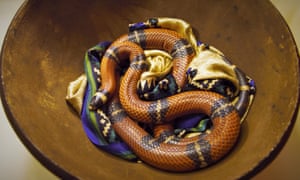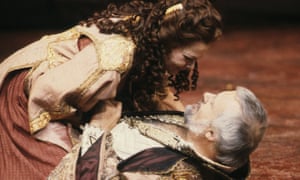Friday, June 21, 2019
Thursday, June 20, 2019
Wednesday, June 19, 2019
Love and hisses: Cleopatra star Sophie Okonedo on acting with live snakes
This article is more than 6 months old
Love and hisses: Cleopatra star Sophie Okonedo on acting with live snakes
This article is more than 6 months old
The actor, who is performing in Shakespeare’s tragedy on the Olivier stage, is to make her National Theatre Live debut with one of her real reptile co-stars

When the National Theatre’s Antony and Cleopatra is broadcast to cinemas in December, Ralph Fiennes and Sophie Okonedo won’t be the only stars getting ready for their close-up. Fiennes is no stranger to NT Live screenings but Okonedo will be making her debut, as will one of four real snakes used in the production.
It has not yet been decided which of the snakes, which are used in rotation throughout the play’s run, will appear in the broadcast. It could be Pork Pie, Hondo, Little J or Larry, who had no name when he arrived for the show but has been christened in honour of the National’s first artistic director and the Olivier stage on which he appears.
Okonedo, who has never worked with animals in the theatre before, said she and director Simon Godwin “felt very strongly before we started rehearsals that it would be a bit of a letdown if we brought out a rubber snake at the end of the show”. When she first handled snakes, she was surprised to find them “the most beautiful and fascinating creatures”.

The snakes are owned by Mark Amey, who specialises in animal handling for film and television. Using his animals in rotation gives them time to rest in between performances. Amey says he is impressed by Okonedo’s multitasking. “She’s got to remember her lines and she’s also got to be a professional snake wrangler. She’s got to get the snake’s head at the right position at the same time as delivering the line at the right point. It’s a big ask.”
The reptiles are all milk snakes, a type of constrictor. They measure one metre long and were chosen for their dramatic colours. Pork Pie was a rescue snake who was rather obese, but the exercise of performing in the show has helped him lose weight. Another of Amey’s snakes, Mr Jangles, was removed from the production because he is “quite fidgety”. He is one of Amey’s most successful snakes on film but theatre work doesn’t suit a snake who likes to “do his own thing”. Hence the casting of Little J.
Advertisement
Four backstage snake carers work on the production. The animals have their own green room at the National: a vivarium, which is a wooden unit with sliding glass doors, controlled lighting and heating, complete with branches for the snakes to climb.

Snakes, says Amey, “are very intuitive to how we feel. If we’re tense or stressed then they become stressed. If you relax and wind down, the snakes wind down.” Okonedo says “I adore all four of the snakes” and that they have become an integral part of her nightly warm-up. “I do lots of humming exercises, which seems to put them in a sort of stupor as they lay across my chest, which is relaxing for me and them, I guess.”
This is not the first time that real snakes have been used for Shakespeare’s tragedy at the National: Judi Dench shared scenes with a snake in a 1987 production co-starring Anthony Hopkins. In the play, an asp is used by the Egyptian queen to kill herself; she places it on her breast and tells the “poor venomous fool” to “be angry”.
The snakes are not the only animals to have taken centre-stage in London in recent years. The Almeida’s production of Ibsen’s The Wild Duck briefly features a real fowl and Jez Butterworth’s The Ferryman – now on Broadway after a successful London run – has a sensational scene with a goose. At the start of its preview period, Harry Potter and the Cursed Child used live owls, but then removed them from the production. The animal rights organisation Peta applauded that decision, saying: “The West End offers many innovative stage productions such as War Horse and The Lion King that create breathtaking effects without exploiting animals.”
- Antony and Cleopatra will be broadcast live to cinemas across the UK and internationally on 6 December as part of National Theatre Live
Since you’re here…
… we have a small favour to ask. More people are reading and supporting The Guardian’s independent, investigative
Tuesday, June 18, 2019
Monday, June 17, 2019
Friday, June 14, 2019
Thursday, June 13, 2019
Wednesday, June 12, 2019
Tuesday, June 11, 2019
structured
00:03
form of learning by doing.
00:05
It’s a process of continued experimentation
00:09
to first achieve mastery and eventually full
00:11
automaticity of a specific skill.
00:14
A 2014 study published in Psychological Science
00:18
argues that it can increase our performance
00:20
by 26% in games, 21% in music and 18% in sports.
00:27
Here are some tips on how to do it well.
00:31
Define Success and Drill Deliberately
00:35
Define all the elements you need to practice
00:38
to become successful.
00:40
Then drill each element deliberately,
00:42
one after the other.
00:44
In Tennis, that could be first your serves
00:46
and then later your leg work.
00:48
If you want to become a professional barista,
00:51
first perfect your moves to make the espresso,
00:54
then your skills to serve the ideal coffee.
00:58
Plan, Reflect and Take Notes
01:02
Plan out your practice routine,
01:04
for example in a notebook.
01:06
After each session,
01:07
reflect and write down what you've discovered:
01:10
What worked?
01:11
What didn’t?
01:13
The idea is to get a clear sense
01:15
of how a particular session improves your skills
01:18
and then to experiment to find new and ever better way
01:21
to achieve your goals.
01:25
Go Slow
01:26
To build a good foundation of muscle memory,
01:29
practice slow and correctly.
01:32
If we move too fast,
01:34
we risk learning and internalizing the wrong skills,
01:37
which can bring terrible consequences.
01:40
To achieve mastery, our brain needs time to develop.
01:43
So start slow and then gradually increase the speed
01:47
until you give all you've got .
01:51
Limit Your Sessions to Focus
01:54
Deliberate practice is hard metal work.
01:57
Limit the sessions to a reasonable duration
02:00
that allows you to stay focused.
02:02
This may be 15 minutes if you are younger
02:04
and 60 minutes if you are older.
02:07
A Cristiano Ronaldo
02:08
trains around 3-4 hours of football a day.
02:12
Young Shaolin Monks practice 2 hours in the morning
02:15
and two hours in the afternoon,
02:17
To keep their attention high,
02:19
they switch the style of practice every 10 minutes.
02:24
Maximize Practice Time
02:26
Legendary basketball coach John Wooden
02:29
used to let each of his players
02:31
practice putting on socks and shoes
02:33
so that they learn to do it really fast.
02:35
By doing this, he maximized the time
02:37
to practice throwing the ball
02:39
and discussing game strategy with his team.
02:43
Track Small Intervals of Improvement
02:46
If you practice running 800 meters,
02:49
count the milliseconds not the minutes.
02:52
If you are working out or practice controlling your diet,
02:55
measure milligrams and millimeters.
02:58
The smaller the data points you measure,
03:00
the faster you see progress
03:02
and the more you feel motivated to continue.
03:06
Emulate Practice, Not Performance
03:09
The top performance we see on screens or on stage
03:13
is the results of endless hard work behind the curtain.
03:16
If you want to become as good as Pavarotti in the Opera
03:19
or as skillful as Messi with the ball,
03:22
don’t watch them perform,
03:24
study how they practice.
03:27
Repetition Makes Perfect
03:30
In the 1990s, a team of German psychologists
03:33
revealed that it takes 10,000 hours of deliberate practice
03:37
to become a professional violinist.
03:39
A similar study concluded it also takes almost
03:42
just as long to become a great cigar maker.
03:45
New workers in a cuban cigar factory
03:47
take around 25 seconds to make one cigar.
03:51
After 100,000 repetitions, it takes them just 15 seconds
03:55
and after 1 million only 8.
03:58
To reach peak performance,
04:00
it takes 7 years and 10 million repetitions of
04:03
the same hand movements.
04:05
Not practice, but repetition makes perfect.
04:09
Professional football teams therefore play daily
04:12
what the Spanish players call "Rondo".
04:15
Piano players warm-up with Scales and Arpeggios.
04:20
Routine Is Everything
04:22
To reach mastery, Young Shaolin Monks
04:25
get up at 5:30AM.
04:28
Then chant, eat breakfast
04:30
and practice two hours of kung fu.
04:32
At 11:30 they have a vegetarian lunch
04:35
with no liquids to aid digestion.
04:38
At around 3PM, they practice another two hours.
04:42
At 5:30 is dinner,
04:44
followed by chanting.
04:45
At 8 meditation.
04:47
At 10 time for bed.
04:50
Us normal people can start with 15 Minutes every day
04:53
and then slowly increase our session.
04:58
Get a Coach
04:59
The job of a coach is to show us our true potential
05:02
and then guide us in the right direction.
05:05
If you don’t have a coach, look for one.
05:07
It can a teacher, a friend
05:10
or even someone you find or follow online.
05:13
For our favorite teachers and coaches,
05:15
visit our sprouts channel page
05:17
and check out our playlists.
05:21
The Dalai Lama believes deliberate practice
05:24
not only works for muscles,
05:26
but also for our mind.
05:28
He and other wise minds
05:30
deliberately practice taking other people's anger,
05:33
suspicion and mistrust
05:35
and then giving them patience,
05:36
tolerance and compassion in return.
05:40
What do you think about deliberate practice,
05:43
can we also use it for training our thinking skills?
05:46
Share your thoughts in the comments below!
English
Subscribe to:
Posts (Atom)




